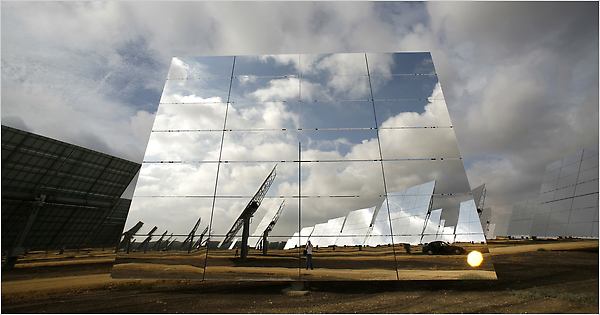 Europe Urged to Share Power Across ContinentApr 14, 2010 - James Kanter - nytimes.com
BRUSSELS — Renewable energy in Europe should be generated and distributed on a continental scale to make the greatest contribution toward reducing greenhouse gases, according to a report that raises significant challenges for a fragmented region. The report, to be released Tuesday, was compiled by the European Climate Foundation, a group financed by philanthropic organizations, using studies carried out by McKinsey, a consulting firm. Among its recommendations is a gigantic power cable that would link solar farms in Spain with energy-hungry countries like Poland. Such a link could ship huge volumes of so-called clean electricity, but it could face political opposition in countries like France. The report underscores how various renewable power sources, including wind from the North Sea, will need to be linked on a transcontinental grid to generate a secure and reliable supply of alternative energy to substitute for fossil fuels. Such a grid would probably be easier to build in countries that span continents, as in the United States and China. In Europe, power grids remain largely confined to countries, with limited cross-border connections. The report, to be presented in Brussels to the European Union energy commissioner, Günther Oettinger, and the climate commissioner, Connie Hedegaard, said that cross-border connections would need to change if clean power was to be distributed more widely. “Transmission must develop from a minor trading and reserve-sharing role to one that enables significant energy exchanges between regions across the year,” according to the report. The addition of a huge interconnector crossing France could help French utilities export more nuclear power, but it also could cut into those exports by providing customers with an alternative source of electricity. Countries including France would need to “consider wider regional benefits than is currently the case,” the report said. Another factor that could impede the plans is longstanding opposition to unsightly pylons and cables in border areas like the Pyrenees, the mountain range between Spain and France. Current capacity between Spain and France is less than a gigawatt and would have to rise to as much as 40 gigawatts to carry sufficient quantities of solar-generated electricity, the report said. Efforts were needed “to change public attitudes regarding the construction of large-scale overhead transmission infrastructure,” it said; otherwise, “alternative solutions” to overhead lines over the Pyrenees, like underground and underwater cables, “may need to be considered.” The European Climate Foundation said it had invited all major European utilities to participate in the study. EDF, which operates nuclear power plants in France, was not involved. A spokeswoman for EDF said it was possible that its subsidiaries were involved in the report, but she had no details. GDF Suez, another French utility with substantial nuclear operations, was involved but did not support the conclusions. A spokeswoman for GDF Suez said she had been unable to obtain an explanation as to why the company had distanced itself from the report. The report also seems to have irritated Alstom, a French engineering company that has a major focus on technology to reduce emissions from electricity plants fueled by coal or natural gas. Alstom participated but did not support the conclusions because it said parts of the report underplayed the role of carbon-capture technologies. A company spokeswoman, Mary Varkados, said Alstom welcomed the report’s main findings, but said that “further work will be needed” on how to reach goals for lowering emissions. Major energy companies that signed the final report included Shell, the English-Dutch oil and gas company, and RWE, a German electric utility that in previous years had produced the most carbon dioxide of any company based in the European Union. RWE is participating in efforts to deliver solar-generated electricity from North Africa. The power sector is currently the biggest emitter of greenhouse gases in many parts of Europe. The report said the European Union would need to combine solar power from Spain with wind power from the North Sea if it were to meet a pledge made last summer to reduce emissions by 80 percent by 2050. That will be expensive but manageable, according to the report. The European Union already will have to invest 4.2 trillion euros, or $5.7 trillion, across the economy over the next 40 years to ensure it continues to generate sufficient power by midcentury, according to the report. To reach its goal of reducing emissions, the bloc would have to invest a total of 7 trillion euros, or about 66 percent more, it said. But the cost of energy to the economy should start to drop as of 2020 because of reduced fossil fuel use and efficiency savings that would help offset the cost of building a low-carbon infrastructure. |
Email this page to a friend
If you speak another language fluently and you liked this page, make
a contribution by translating
it! For additional translations check out FreeTranslation.com
(Voor vertaling van Engels tot Nederlands)
(For oversettelse fra Engelsk til Norsk)
(Для дополнительных
переводов проверяют
FreeTranslation.com )


